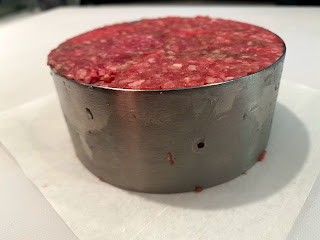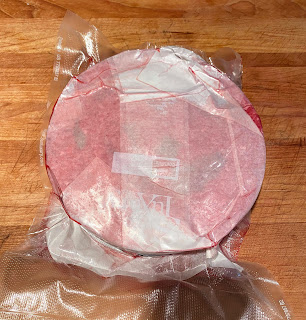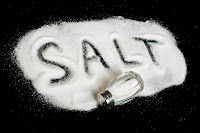(Sous-Vide) Does Diameter affect Thermal Diffusion?
Fact or Fiction does diameter make a difference? Does size matter (No-pun-intended)? We've all been told or instructed to the point of nausea that it does not! In almost everything written on the subject will tell you that diameter does not make a difference. The great body of experts now accepts the substantial genuineness that diameter is of no importance. Thermal mass is never discussed. But is this true? In food groups, I Admin/Mod I've had always towed that same line until now.
Before we get into the nuts & bolts, I wanted to give you a little backstory to this post's genesis. It all started back in February with this post, "The Tale of Three Ribeyes." Towards the bottom, I more or less made the assertion that size matters regarding heat transfer. I made this statement without any real data except what I believed to be correct. Some were based on conjecture and scant data. Anyhow, I got into this great conversation with a Chef named Dave. It was a fruitful, respectful conversation, and I told Dave that I would come up with some type of analysis with supporting data to prove my theory. Anyhow, here we go.
What is thermal diffusion? What is thermal mass? This subject on its own would require an overabundance of posts just to scrape the surface, but maybe a slight caress will suffice. I gotta give homage to Dr. Douglas Baldwin because he covered a lot of this in his book (LINK). Read his footnotes and the appendix. I'll admit it's not an easy read meaning it's undoubtedly nontrivial and requires a deep dive.
Yeah, I know I keep bringing up Baldwin, but he single-handedly transformed Sous-Vide into what we have today. In 2006, Dufresne battled Mario Batali on Iron Chef America; it was the first time sous vide circulators were seen on TV. This was the first time I became acquainted with this cooking method, which turned my world upside down. I started hanging out in the E-gullet forums and became acquainted with the cooking method and names like Nathan Myhrvold and Baldwin. I was completely lost until Baldwin's work became available for the masses.

 In the Modernist Cuisine Books, they too touch on the subject but not directly. It's spread out in several chapters that discuss Sous-Vide and Thermal Dynamics. The MC- Books (Book 2- Chapter 9) have 4 Tables that consider cylinder and slab style cuts. They consider not only thickness but length and diameter. Their tables were produced using specific thermal diffusivity values as well as thermodynamic values. These tables estimate the water bath set at 1℃/2℉ higher than the core temperature you want the food to achieve (Hotter-Than-Core-Approach). To be honest, I prefer Baldwins tables over theirs. MC's tables are complicated. MC also states the tables are approximate because of the various variables, and if you are processing something critical, use SV-Probes.
In the Modernist Cuisine Books, they too touch on the subject but not directly. It's spread out in several chapters that discuss Sous-Vide and Thermal Dynamics. The MC- Books (Book 2- Chapter 9) have 4 Tables that consider cylinder and slab style cuts. They consider not only thickness but length and diameter. Their tables were produced using specific thermal diffusivity values as well as thermodynamic values. These tables estimate the water bath set at 1℃/2℉ higher than the core temperature you want the food to achieve (Hotter-Than-Core-Approach). To be honest, I prefer Baldwins tables over theirs. MC's tables are complicated. MC also states the tables are approximate because of the various variables, and if you are processing something critical, use SV-Probes.
 Let's dive into a little Science. I'll attempt to paraphrase what MC-Books wrote about Fourier (Jean-Baptiste Joseph Fourier was a French mathematician and physicist ) and the Heat-Equation. Look this guy up because he is responsible for many physics, chemistry, biology, social science, finance, and cooking discoveries. I'm going to strive to simplify what is undoubtedly a complex subject. The geometry of food helps us understand conduction and how heat transfer works with different shapes and sizes. Heat-Transfer not only depends on the size (Thickness) but shape. I will summarize their words- A Steak 2"/5 cm thick will take 4 x longer to cook than a steak that is 1"/2.5 cm thick. Yea, one would think you would double the time, but that doesn't work. Heat-Transfer, Thermal Mass, and Conduction can get complicated.
Let's dive into a little Science. I'll attempt to paraphrase what MC-Books wrote about Fourier (Jean-Baptiste Joseph Fourier was a French mathematician and physicist ) and the Heat-Equation. Look this guy up because he is responsible for many physics, chemistry, biology, social science, finance, and cooking discoveries. I'm going to strive to simplify what is undoubtedly a complex subject. The geometry of food helps us understand conduction and how heat transfer works with different shapes and sizes. Heat-Transfer not only depends on the size (Thickness) but shape. I will summarize their words- A Steak 2"/5 cm thick will take 4 x longer to cook than a steak that is 1"/2.5 cm thick. Yea, one would think you would double the time, but that doesn't work. Heat-Transfer, Thermal Mass, and Conduction can get complicated.
The method outlined in the MC books is called Scaling and approximates the Fourier heat equation. Let's not forget Baldwin did all of this for us in his tables. MC-Volume 1 "The general rule for estimating cooking time for flat cuts is that the time required increases by the square of the increase in thickness. Two times thicker means four times longer; three times thicker means nine times longer." They state the scaling method goes out the window when the thickness dimension changes drastically, i.e., cubed, cylinder, or sphere. They say that computer simulations demonstrate that when the length and width are 5x, the thickness (block of food), or when the length is 5 x the diameter (cylinder), then the scaling rule works. So, in the end, I want to empathize with two things. Size and dimensions count, Heat-Transfer occurs edge to edge, top and bottom, and in every direction.
 Heating food with efficiency is an excellent place to start when you consider using Sous-Vide's cooking method. Choosing the right Vessel (Holds the Water) to match the Immersion Circulator power output is a good start. Always make sure the cooking vessel is covered to avoid water evaporation. What most people don't know is evaporation has a cooling effect on hot liquids. I experimented a while back and put probes in two corners of the container with the lid off and noticed some mild temp differences. Now imagine putting cold food in the container. I don't know about you, but I want a uniform heat distribution. So do yourself a favor and cover the container. No cover? Use plastic wrap. And if you really want to make everything more efficient, use an insulated container. I use a polycarbonate container, and on long cooks, I use blankets to insulate the outside.
Heating food with efficiency is an excellent place to start when you consider using Sous-Vide's cooking method. Choosing the right Vessel (Holds the Water) to match the Immersion Circulator power output is a good start. Always make sure the cooking vessel is covered to avoid water evaporation. What most people don't know is evaporation has a cooling effect on hot liquids. I experimented a while back and put probes in two corners of the container with the lid off and noticed some mild temp differences. Now imagine putting cold food in the container. I don't know about you, but I want a uniform heat distribution. So do yourself a favor and cover the container. No cover? Use plastic wrap. And if you really want to make everything more efficient, use an insulated container. I use a polycarbonate container, and on long cooks, I use blankets to insulate the outside.

The photo was taken out of MC Book to illustrate a point. Don't overload your vessel. Even if your Immersion Circulator had the power to heat the water, it would still have cold spots. A significant disparity in the Protein to Water ratio (Total Thermal Mass) will result in uneven heat distribution. Is there a magical number for ratios? I am sure there is, but that's for mathematicians. The bottom line, don't overload your vessel and make sure there is adequate circulation. The picture to the right (This PIC from FB SV-Groups) illustrates everything not to do. Let's briefly examine everything this person did wrong. The container had no Cover (maybe because of the picture? I doubt it because of comments). The abysmal water to protein ratio is so bad that there is no water circulation. When proteins touch or are stacked, the cooking time is squared or thereabouts. I.e., Using Baldwins tables for Pasteurization for Beef at 131f at 25mm is 2 3/4 Hours vs. 50mm at 4 1/2 Hours. I SV-Process a lot of burgers, and this photo shows me a few things. Properly vac sealed food do not float, which means they're stacked, and there is virtually no circulation. I'll conclude with DON'T DO THIS!
I've read several articles with great insight into Heat, Temperature, Thermal Dynamics, and Sous-vide. Some of their analogies could be used to understand what's actually happening when we Sous-Vide-Process food. Here is one from Serious Eats. Their Chicken Coop, Chicken & RedBull analogy is spot on. You may have to read it several times and contemplate how this applies to SV. I don't want to give it away, but it does make you think outside the box a little. Another one is from Sous-Vide Living that touches on THERMODYNAMICS OF SOUS-VIDE.
 I used molds that were 1.77" inches (45 mm) and 8,6,4,3, and 2 inches in diameter. The 2" Mold is more of a cylinder because of the ratio to its height.
I used molds that were 1.77" inches (45 mm) and 8,6,4,3, and 2 inches in diameter. The 2" Mold is more of a cylinder because of the ratio to its height.
Why the drill? I had to drill a hole in the center of each mold. I wanted to be as accurate as possible. Running probes in from the top IMO would not be as accurate.


If you want to be precise, one must use an electronic caliper. I also used a vice to stabilize the mold while I drilled through. And as you can see, I used a file to smooth out the rough edges. Click on the photo to enlarge.

Each mold was filled with my custom blend of meats, which came in at about 23% Fat. I used Brisket, Short-Rib, and Top-Sirloin. Top and Bottom covered with parchment paper.

This is how I got the probe inside. I have different length probes to accommodate the diameters.


Before we get into the nuts & bolts, I wanted to give you a little backstory to this post's genesis. It all started back in February with this post, "The Tale of Three Ribeyes." Towards the bottom, I more or less made the assertion that size matters regarding heat transfer. I made this statement without any real data except what I believed to be correct. Some were based on conjecture and scant data. Anyhow, I got into this great conversation with a Chef named Dave. It was a fruitful, respectful conversation, and I told Dave that I would come up with some type of analysis with supporting data to prove my theory. Anyhow, here we go.
What is thermal diffusion? What is thermal mass? This subject on its own would require an overabundance of posts just to scrape the surface, but maybe a slight caress will suffice. I gotta give homage to Dr. Douglas Baldwin because he covered a lot of this in his book (LINK). Read his footnotes and the appendix. I'll admit it's not an easy read meaning it's undoubtedly nontrivial and requires a deep dive.
Thermal diffusivity is a measure of the rate at which heat disperses throughout just about anything. Thermal Conductivity is a measure of how easily one atom or molecule accepts or gives away heat. In Sous-Vide Processed food, the idea behind thermal diffusion is the ability to calculate the rate at which heat diffuses through the protein.
Thermal mass is equal to thermal capacitance or heat capacity. All of these terms apply to the cooking method known as Sous-Vide. Think of Water and Protein.
Let's talk about thermal Conductivity for a second because this, too, applies to Sous-Vide cooking. Thermal Conductivity is the ability to transfer heat, which is directly related to food thermal properties. Food thermal properties (I am talking protein) are based on those properties that control heat transfer to a specific food, I.E., Most land animal muscle is roughly 75% water, 20% protein, and 5% fat, carbohydrates different proteins. Thermal Conductivity, Thermal Mass, and Thermal diffusion are all intertwined in Sous-Vide cooking.
We are fortunate that Dr. Baldwin computed all the numbers for us and the tables we come to depend on for Sous-Vide processed foods. Other tables can be found in the Modernist Cuisine Books (Book 3-Chapter 9), but they are unfavorable to the average user. Take a look at Dr. Baldwin's work in Appendix III (Mathematics of Sous-Vide).
The shape of it all?
Of course, this makes a difference. I used round molds as my muse, but I have done this same experiment with Square, Rectangle, etc., and it makes a difference. The point of this? Heat Transfer occurs at the sides also. Take a 6" x 6" Square vs. a 6" x 12" Rectangle; which one will come to temp first? The 6" x 6" one will reach equilibrium first. The shortest distance between two points is a straight line.
Also, let's not forget the overall Thermal mass too—many many variables to consider. I.E., Place a 12 lb Brisket into a 30 Liter container vs. two 12lb Briskets into the same body of water, and again everything being equal, the single Brisket will equalize faster. It's all about Heat-Transfer and Thermal Mass. It's not exclusive to just these two variables but many other factors.
Dr. Baldwin has covered some of this in his work in the Appendix. Lots and lots of math. In his tables, he explicitly states Slab-like, Cylinder-like, and Spere-like. Since I used something flat (slab-like), although round Dr. Baldwin's table for beef for Slab-like worked perfectly. Let's not forget; I also used SV-Probes.

 In the Modernist Cuisine Books, they too touch on the subject but not directly. It's spread out in several chapters that discuss Sous-Vide and Thermal Dynamics. The MC- Books (Book 2- Chapter 9) have 4 Tables that consider cylinder and slab style cuts. They consider not only thickness but length and diameter. Their tables were produced using specific thermal diffusivity values as well as thermodynamic values. These tables estimate the water bath set at 1℃/2℉ higher than the core temperature you want the food to achieve (Hotter-Than-Core-Approach). To be honest, I prefer Baldwins tables over theirs. MC's tables are complicated. MC also states the tables are approximate because of the various variables, and if you are processing something critical, use SV-Probes.
In the Modernist Cuisine Books, they too touch on the subject but not directly. It's spread out in several chapters that discuss Sous-Vide and Thermal Dynamics. The MC- Books (Book 2- Chapter 9) have 4 Tables that consider cylinder and slab style cuts. They consider not only thickness but length and diameter. Their tables were produced using specific thermal diffusivity values as well as thermodynamic values. These tables estimate the water bath set at 1℃/2℉ higher than the core temperature you want the food to achieve (Hotter-Than-Core-Approach). To be honest, I prefer Baldwins tables over theirs. MC's tables are complicated. MC also states the tables are approximate because of the various variables, and if you are processing something critical, use SV-Probes.  Let's dive into a little Science. I'll attempt to paraphrase what MC-Books wrote about Fourier (Jean-Baptiste Joseph Fourier was a French mathematician and physicist ) and the Heat-Equation. Look this guy up because he is responsible for many physics, chemistry, biology, social science, finance, and cooking discoveries. I'm going to strive to simplify what is undoubtedly a complex subject. The geometry of food helps us understand conduction and how heat transfer works with different shapes and sizes. Heat-Transfer not only depends on the size (Thickness) but shape. I will summarize their words- A Steak 2"/5 cm thick will take 4 x longer to cook than a steak that is 1"/2.5 cm thick. Yea, one would think you would double the time, but that doesn't work. Heat-Transfer, Thermal Mass, and Conduction can get complicated.
Let's dive into a little Science. I'll attempt to paraphrase what MC-Books wrote about Fourier (Jean-Baptiste Joseph Fourier was a French mathematician and physicist ) and the Heat-Equation. Look this guy up because he is responsible for many physics, chemistry, biology, social science, finance, and cooking discoveries. I'm going to strive to simplify what is undoubtedly a complex subject. The geometry of food helps us understand conduction and how heat transfer works with different shapes and sizes. Heat-Transfer not only depends on the size (Thickness) but shape. I will summarize their words- A Steak 2"/5 cm thick will take 4 x longer to cook than a steak that is 1"/2.5 cm thick. Yea, one would think you would double the time, but that doesn't work. Heat-Transfer, Thermal Mass, and Conduction can get complicated. The method outlined in the MC books is called Scaling and approximates the Fourier heat equation. Let's not forget Baldwin did all of this for us in his tables. MC-Volume 1 "The general rule for estimating cooking time for flat cuts is that the time required increases by the square of the increase in thickness. Two times thicker means four times longer; three times thicker means nine times longer." They state the scaling method goes out the window when the thickness dimension changes drastically, i.e., cubed, cylinder, or sphere. They say that computer simulations demonstrate that when the length and width are 5x, the thickness (block of food), or when the length is 5 x the diameter (cylinder), then the scaling rule works. So, in the end, I want to empathize with two things. Size and dimensions count, Heat-Transfer occurs edge to edge, top and bottom, and in every direction.
 Heating food with efficiency is an excellent place to start when you consider using Sous-Vide's cooking method. Choosing the right Vessel (Holds the Water) to match the Immersion Circulator power output is a good start. Always make sure the cooking vessel is covered to avoid water evaporation. What most people don't know is evaporation has a cooling effect on hot liquids. I experimented a while back and put probes in two corners of the container with the lid off and noticed some mild temp differences. Now imagine putting cold food in the container. I don't know about you, but I want a uniform heat distribution. So do yourself a favor and cover the container. No cover? Use plastic wrap. And if you really want to make everything more efficient, use an insulated container. I use a polycarbonate container, and on long cooks, I use blankets to insulate the outside.
Heating food with efficiency is an excellent place to start when you consider using Sous-Vide's cooking method. Choosing the right Vessel (Holds the Water) to match the Immersion Circulator power output is a good start. Always make sure the cooking vessel is covered to avoid water evaporation. What most people don't know is evaporation has a cooling effect on hot liquids. I experimented a while back and put probes in two corners of the container with the lid off and noticed some mild temp differences. Now imagine putting cold food in the container. I don't know about you, but I want a uniform heat distribution. So do yourself a favor and cover the container. No cover? Use plastic wrap. And if you really want to make everything more efficient, use an insulated container. I use a polycarbonate container, and on long cooks, I use blankets to insulate the outside. 
 |
I've read several articles with great insight into Heat, Temperature, Thermal Dynamics, and Sous-vide. Some of their analogies could be used to understand what's actually happening when we Sous-Vide-Process food. Here is one from Serious Eats. Their Chicken Coop, Chicken & RedBull analogy is spot on. You may have to read it several times and contemplate how this applies to SV. I don't want to give it away, but it does make you think outside the box a little. Another one is from Sous-Vide Living that touches on THERMODYNAMICS OF SOUS-VIDE.
 I used molds that were 1.77" inches (45 mm) and 8,6,4,3, and 2 inches in diameter. The 2" Mold is more of a cylinder because of the ratio to its height.
I used molds that were 1.77" inches (45 mm) and 8,6,4,3, and 2 inches in diameter. The 2" Mold is more of a cylinder because of the ratio to its height. Why the drill? I had to drill a hole in the center of each mold. I wanted to be as accurate as possible. Running probes in from the top IMO would not be as accurate.



Each mold was filled with my custom blend of meats, which came in at about 23% Fat. I used Brisket, Short-Rib, and Top-Sirloin. Top and Bottom covered with parchment paper.



Modus Operandi- The Immersion Circulator was calibrated the previous week, and everything was processed at 131℉. A polycarbonate container was used and was filled exactly with 30 l of water. Each mold was processed separately. Yes, each mold had its own bath. I felt preparing several together would have skewed the results because of the increase in thermal mass.
Total Meat used was 3200 grams or 7 lbs. I used more like 12-lbs because I played around with other molds and shapes.
To answer the question posed in the title, Does Diameter affect Thermal Diffusion? We have an emphatic YES.
As stated in the table, Heat-Transfer slows as it approaches the target temp. After about 50 cooks, I've also noticed that as the thickness increases (other variables too), the time to reach that last .5℉ degree is exponential.
Note: All Burgers were cooked to pasteurize. Chart only reflects Time to Temp.
I have several more experiments coming that will be addendums.
 |
| Click to enlarge |
To answer the question posed in the title, Does Diameter affect Thermal Diffusion? We have an emphatic YES.
As stated in the table, Heat-Transfer slows as it approaches the target temp. After about 50 cooks, I've also noticed that as the thickness increases (other variables too), the time to reach that last .5℉ degree is exponential.
Note: All Burgers were cooked to pasteurize. Chart only reflects Time to Temp.
I have several more experiments coming that will be addendums.




















Comments
Post a Comment